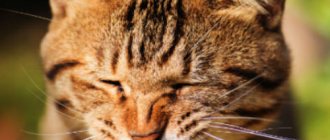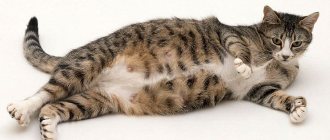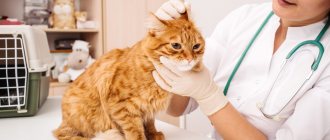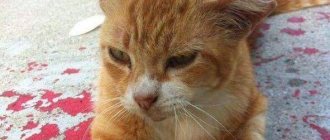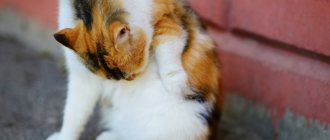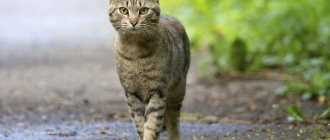My cat is constantly sneezing. What to do?
Have you ever seen a little kitten scrunch up its nose and suddenly let air out through its nostrils with a cute sneeze? It sounds like "Pfft!" and may or may not be accompanied by the discharge of a few drops of fluid or snot.
People almost always sneeze for some reason. If your indoor cat sneezes occasionally and is otherwise active and healthy, you probably have nothing to worry about. However, if your cat's sneezing is not random or is accompanied by blood or mucus, or if your cat has eye discharge or coughing at the same time, the sneezing may be a sign of more serious health problems.
If you are concerned about this symptom in your pet or are simply curious about the issue, this article provides information on some possible reasons why your kitten may be sneezing.
Heartworm infection in a cat
It is extremely rare, but still occurs in practice, that such cute creatures as cats become infected with heartworms when they find themselves in places with very high air humidity and a maximum number of mosquitoes. Why these insects? Yes, because it is through their bite that the parasite is transmitted to the pet. The heartworms themselves, once in the cat’s body, affect the right side of the heart, as well as the lungs. As a result, the arteries become clogged, it becomes difficult to breathe, and coughing and sneezing begins. And the end is often sad - a heart attack and death.
To protect your mustachioed pet from these parasites, follow the following preventive measures:
- maintain strong immunity,
- ensure proper diet and lifestyle.
And when traveling outdoors, you can prepare a special mosquito repellent in advance (dilute citronella with plain water). This composition will reduce the risk of parasite infection to a minimum, which will undoubtedly preserve the health and, of course, the life of your pet. This is just the simplest measure to prevent infection with malicious worms. Your veterinarian will cover this topic in more detail.
Causes of sneezing in small pets
- Simple, mild tickling or irritation of the nasal mucosa.
This may be the most
obvious cause of sneezing in domestic cats.
A simple irritation in a cat's nose, such as dust or a mild chemical irritant, can cause a reflex sneeze. Remember the animated cat Tom, who sneezes whenever he inhales some pepper. This type of sneezing is not much different from scratching, tickling or itching. In such a situation, there is no need to worry. - Respiratory infections.
Another common cause of sneezing is due to a respiratory infection, most often a viral or bacterial infection. It's true, our pets can catch colds too! Possible infections include: Herpes virus Calicivirus Chlamydial infections Bacterial infections such as mycoplasma Less common are fungal infections that can also cause frontal sinus disease, which often leads to a sore nose. Viral respiratory infections may be accompanied by a cough and, more often, excessive inflammation, redness, or discharge that accumulates in the eyes. In this case, the respiratory disease is complicated by conjunctivitis. - Chemical irritants to the nasal cavity.
Sometimes toxic substances or chemical fumes associated with various solvents can cause inflammation of the linings of the nose and sinuses. Sneezing is the body's way of ridding itself of this irritation. Some cats may also be sensitive to inhaled tobacco smoke, perfumes, and various chemicals. Small pets are also susceptible to secondhand smoke. - Foreign bodies.
Foreign objects in the nasal cavity, such as blades of grass or spiky spikelets, can penetrate the nasal cavity. Firstly, it is an irritation, and if the object is not removed from the nasal cavity during the sneezing process, there is a possibility of infection. - Dental diseases.
Dental disease can also cause sneezing, especially when an infection develops in the area of the roots of the teeth. Dental infections in cats can allow bacteria to colonize the sinuses, resulting in inflammation of the nasal cavity and subsequent sneezing by the animal. - Allergy to pollen.
Allergies to pollen are much less common in cats than in people, but are not uncommon. - Intranasal vaccines.
Vaccines that are designed to fight respiratory infections are given intranasally and often cause sneezing for several days after they are given. The sneezing usually lasts only a few days and goes away on its own without requiring any treatment.
If your cat sneezes only occasionally, treatment is usually not required. However, if your cat has other symptoms, such as nasal or eye discharge, blood or mucus in the nose, decreased activity, or loss of appetite, have your veterinarian examine your cat.
If you have any questions or concerns, you should always visit or call your veterinarian—they are your best resource for ensuring the health and well-being of your pets.
My cat sneezes and snorts. What's the matter? General information
Sneezing and snorting seem like obvious enough signs to identify, but it's not always easy to tell them apart in pets. Indeed, these two symptoms can sometimes appear so that many people use the terms interchangeably. Sneezing is usually defined as a sudden, involuntary movement of air from the lungs through the nose and mouth. This phenomenon usually occurs in response to some irritant of the upper respiratory tract, most often to the thin receptor structures of the mucous membrane that lines the nasal passages.
A snort, on the other hand, looks and is identically defined as a sneeze. The difference is that sneezing is involuntary, while snorting is a voluntary effort on the part of the pet.
Dogs and cats sneeze and snort for a variety of reasons related to the functioning of the upper respiratory tract. While many are normal and benign reactions to simple irritation, some may signal infections, upper airway obstructions, and allergic diseases. There are also other pathological conditions of the upper respiratory tract.
Sounds
The more we communicate with our pets, the more they communicate with us. Cats are very receptive and capable of learning by imitating the object that interests her. Perhaps that is why the intonations of the sounds they make are very similar to human speech: it can be affectionate, questioning, or demanding purring.
Every cat knows how to get exactly what it wants from a person using sounds of different intonations.
For example, a cat asks for feeding in a drawn-out and long tone at low frequencies, and if she wants the owner to give her attention and care, the cat makes short sounds simultaneously at low and high frequencies, which have a beneficial effect on a person’s mood.
123RF/Nikita Melnikov
By meowing, small pets try to attract attention to themselves, adapt this sound to each situation and express their desires. Some of them “tell” when they go to the toilet or simply enter the room.
There are also unpleasant, frightening sounds in a cat's arsenal, such as hissing or snorting. In this way, animals express their displeasure or defend themselves. During fights, cats can make completely unimaginable sounds - screams, screams and growls. But if a cat is cornered and cannot escape, it makes a strange sound in its throat (howl). This suggests that, despite the fright, she has not yet completely lost her aggressiveness and can go on the attack.
Sometimes cats make a rather strange, quiet "clack" sound when they are prowling for prey or when they see a bird outside the window. This sound is used by mother cats to draw the attention of kittens to potential prey.
There is also a silent meow, when a cat opens its mouth but does not make any sound. In fact, sound is still produced, but our ear does not perceive it.
The characteristic purring sound of a cat is produced by the vibration of two folds of the mucous membrane located in the lower part of the larynx. It is commonly thought that this is a sign that the cat is happy, but this is not always so clear. Rumbling consists of several sounds that vary in frequency and intensity, allowing a cat to express a wide range of feelings. The “rougher” the purr, the more distinct the sounds become in each beat, which means that the cat’s pleasure has reached its maximum level. When a cat becomes bored or begins to doze off, the purring softens and it becomes more difficult to distinguish its beats.
Sneezing:
- Infectious diseases.
Both cats and dogs can suffer from infectious diseases that manifest themselves, at least in part, as sneezing. In fact, almost any infectious disease that affects the upper respiratory system can cause sneezing in an animal. In dogs, everything from kennel cough syndrome to distemper virus to nasal cancer can cause sneezing. In cats, viral upper respiratory tract infections (eg, feline herpesvirus) are the most common causes. - Obstruction of the upper respiratory tract.
Everything from malignant tumors to benign polyps, from foreign bodies to tissue growths in the upper respiratory tract (most often the result of brachycephalic syndrome seen in these breeds) can cause irritation of the nasal passages and therefore sneezing. - Allergies (or other immune system diseases).
Although allergic rhinitis is not as common in pets as it is in humans, it is still quite common. Dogs and cats are susceptible to allergies that affect the nasal passages, as well as nasal inflammation for a number of other processes related to the immune system. - Inhaled irritants.
Dust, perfume, carpet powders, pollen and other common inhaled irritants can cause sneezing in dogs and cats.
Runny nose with blood
Such symptoms may be signs of tumors in the nose - tumors, polyps.
The cat often rubs its nose, sneezes, deformation of the muzzle may be observed, breathing and swallowing are difficult. Sometimes the animal shakes its head, and the timbre of its voice may change. Only a veterinarian can rid a cat of polyps and tumors - surgically.
White or yellow discharge with blood and purulent clots are symptoms of sinusitis. At the same time, the cat does not have a stuffy nose, the animal breathes freely, but often sneezes. This complication of a cold is treated with antibiotics prescribed by a veterinarian.
Inhalation of foreign bodies or aspiration:
- Obstruction of the upper respiratory tract.
Like people who snore heavily and have sleep apnea, many dogs and cats who have mechanical obstructions in the upper airways (usually inherited as part of what is called "brachycephalic syndrome") snort more often than other pets in an obvious attempt to clear the airways of foreign bodies or fluid. Indeed, any condition that causes enough irritation in a pet to require clearing of the nasal passages can lead to snorting. - Obesity and excess weight.
Cats that are overweight due to adipose tissue tend to exhibit symptoms similar to those seen in animals with upper airway obstruction or respiratory tract irritation from other causes. They will also snort more often than other pets.
.
Foreign object caught in the respiratory tract
Typically, such an unpleasant situation is typical of young individuals, who are more playful and active. Although there are also mature animals that have not lost their playfulness and desire to play. It is extremely rare, but it happens that small objects get into the respiratory tract of pets. If you personally see that an animal has inhaled a button, a bead, a small piece of equipment or a toy, or you suspect this option, do not hesitate - go to the veterinarian. Without special medical tools and skills, you are unlikely to be able to remove the item. And remember - delay increases the risk for the life of such a dear pet.
Reverse sneezing:
While sneezing and snorting are expulsions of air from the nose/mouth, "reverse" sneezing is an involuntary, spasmodic inhalation that some dogs exhibit. Episodes of such abnormal breathing can last several minutes. It's not uncommon for a dog to do this after being walked and breathing something (dust, pollen, dirt) into its nose.
Many dog owners see reverse sneezing and initially assume their dog is choking or in crisis. While this is alarming to the uninitiated owner, there is nothing more to this condition than irritation of the tissues in the back of the throat and soft palate. This sign is completely benign. It can also occur with tracheal collapse.
Poses
With their appearance, cats can demonstrate not only friendliness, humility and harmony, but also resentment, pride, and arrogance. As soon as you yell at a pussy for some offense, it will immediately become offended, turn its back to the owner and stop responding to its name. But in fact, this is how the cat simply “switches off” from the stimulus.
You can often notice how one of the ears of a sleeping cat turns slightly and the tip of its tail trembles a little. This means that something has attracted her attention, and she is too lazy to turn around and look at the source of the sound, but curiosity does not give rest.
123RF/lithian
When a cat arches its back, bristles its fur and turns sideways, it is ready for war. In this way, she tries to “get bigger” and scare a potential enemy.
What should I do at home if my pet sneezes?
All pets that are experiencing sneezing and snorting with increasing frequency should visit a veterinarian. Here are a couple of simple, common sense tips for pet owners whose animals sneeze or snort constantly.
- Limit your pet's movement.
Place your pet in a crate or small area (such as a bedroom or bathroom) to observe his behavior. - Don't overload your pet.
Long walks or exercise should be avoided until you can take your pet to the vet. - Take your pet's temperature.
If your pet has a high fever (over 40-41 degrees), contact your veterinarian as soon as possible.
If your pet is suffering from other obvious symptoms, such as difficulty breathing, pain, poor appetite, or is simply acting differently than usual, take him to the vet immediately - if necessary, to a hospital with a intensive care unit. Additionally, if there is nasal discharge or the sneezing is productive, meaning mucus, blood, or other discharge is produced, your pet should see a doctor. These are usually signs of a more urgent health condition than the advice given here.
If you don't know what to do, call your veterinarian or animal emergency clinic.
Treatment
In order to effectively combat cat sneezing, you must first find out the cause of this phenomenon. If your pet exhibits an allergic reaction in this way, it is necessary to exclude the allergen from all areas of possible contact. If the cause of sneezing is an infectious disease, then you can support the animal during the period of exacerbation of the infection with the help of specialized medications.
However, the best way to avoid such a painful condition is preventive vaccination against a number of feline diseases, such as:
- cat flu;
- feline panleukopenia;
- feline leukemia;
- rabies.
If your animal is vaccinated according to age, then there is no danger from the above diseases. However, if your pet does get sick for any reason, you will have to do everything possible to alleviate its condition and support the body in the fight against the disease. First of all, you need to strictly follow all the veterinarian’s instructions, clean the animal of secretions, and if the pet’s health worsens, immediately contact the clinic.
What can your veterinarian do?
When you take your pet to the vet, here's what the doctor may do:
- Analyze the history of the disease.
Most veterinarians will start asking a few questions to understand the history of the problem. When did you first notice sneezing or snorting? What has changed in your general condition? How did your pet feel before? - Conducting a clinical examination.
Because there are many possibilities for these symptoms to occur, whole-body examination is a necessary part of the diagnostic process. - Conducting laboratory diagnostics.
In these cases, a blood test is usually performed. In addition to basic TCA and biochemistry, specific tests may help identify certain infectious or allergic diseases. - Taking x-rays and other photographs.
If brachycephalic syndrome, tumor, or upper airway obstruction/foreign bodies are suspected, an x-ray will often be performed. Sedation or anesthesia may be required to obtain good X-ray images. Sometimes additional imaging techniques are required: ultrasound, CT and/or MRI. - Conducting a visual examination under sedation or anesthesia - rhinoscopy.
Pet anesthesia is usually a necessary procedure to thoroughly evaluate pets that sneeze or snort. It may be necessary to use a rigid or flexible scope to visualize the tissues of the nose and upper respiratory tract. Once there, your veterinarian may even take tissue samples (biopsy) for microscopic diagnosis (histology).
Why is my cat sneezing?
Have you ever observed your cat sneezing? Don't worry, an occasional sneeze is no big deal! When a cat sneezes, it simply releases high-pressure air from its nose and mouth.
However, if your cat is sneezing excessively and has snot
(more than several times a day or more than several days in a row), a visit to the veterinarian's office may be required. This is especially important if you notice additional clinical signs other than sneezing, such as:
- Runny nose, sour eyes, snot
- Squinting of the eyes (which may be associated with corneal ulcers)
- Nasal discharge (usually clear, but may turn yellow)
- Lethargy
- Difficulty or pain in chewing food (due to ulcers on the tongue or mouth)
- Drooling (due to ulcers on the tongue or mouth)
- Bloody nasal discharge or nosebleeds
- Lack of appetite/anorexia
- Decreased appetite or hyporexia
- Red eyes (eg, red eyes due to secondary inflammation of the conjunctiva)
- Mouth ulcers
- Noisy breathing
- Increased or difficulty breathing
- Dehydration or sudden weight loss
- Fever
- Weight loss
- Swelling around the nose or deformed nose
Deviated nasal septum
May be a birth defect or due to illness or injury. A deviated nasal septum occurs in cats of all breeds, regardless of the type of muzzle. The condition may not affect the quality of breathing, while increasing the “musicality” of the pet and causing it to:
- grunt;
- wheeze;
- coo (like doves);
- gurgle;
- snore
Sounds that are loud enough are sometimes the only problem. If your cat grunts when breathing, but there are no other disturbances or discomfort, there is no need to worry about the nasal septum. But it is better to regularly show your pet to the doctor - the usual sounds may have a new reason, such as a runny nose or pneumonia.
Neoplasms
Heavy breathing in a cat can be caused by polyps. Most often, such neoplasms appear in animals under 2 years of age. But cases of the formation of polyps in older individuals have been recorded. Veterinarians have differing opinions about the cause of their appearance. According to different versions, nasal polyps are formed due to:
- hereditary mutations;
- antibiotic treatment;
- long-term or chronic inflammation of various natures.
The formations impair the sense of smell, creating the likelihood of decreased interest in food. If polyps are present, the cat sniffles through its nose when breathing; Snoring and shortness of breath appear after physical activity. Treatment consists of surgical removal of part of the tumors, since it is difficult to completely remove the grown masses. The bases of the polyps remain. Doctors do not cut them out to avoid damaging the nerves and airways. As a result, there is a possibility of relapse.
The fact that the cat wheezes when breathing may be the reason for the return of polyps. Veterinarians will prescribe corticosteroids and anti-inflammatory drugs to slow the growth of the growths, but further surgery will sooner or later be required.
Polyps are benign formations that are not prone to degeneration into cancer. But difficulty breathing in a cat can also be caused by oncology. Nasal adenocarcinoma is a slowly developing disease that most often affects males and large breeds.
What can cause sneezing?
Typically, sneezing can be associated with:
- Allergens such as dust, pollen and pet dander
- Foreign objects such as grass, small pieces of plant seeds, etc.
- Viral upper respiratory tract infections (eg, calicivirus, herpesvirus)
- Inflammation of the upper respiratory tract (eg, rhinitis)
- Infection in the lungs (eg, pneumonia, bronchopneumonia), Secondary upper respiratory tract infections
- Infectious causes (eg, upper respiratory tract infections, fungal infections, etc.).
- Cancer (often squamous cell carcinoma of the nasal cavity)
- Polyps are relatively benign neoplasms of the nasal cavity.
How bad can the causes of sneezing be? Main reasons why my cat sneezes?
What is the prognosis for this symptom in small pets?
If your cat's symptoms include sneezing, squinting, drooling, snot, and you just brought home a new kitten, especially from an animal shelter, the cause is usually an upper respiratory tract infection (commonly called an "URI") caused by a calicivirus or herpesvirus. . Fortunately, the prognosis is satisfactory for animals with acute respiratory infections. Because these viruses are highly contagious to other cats (but not to people, so don't worry!), you should ensure that symptomatic cats are isolated and ensure that your cats are up to date on vaccinations (quality vaccines should be used). These biologically active drugs should help protect against some strains of these viruses). Keep in mind that just as the herpes virus can hide in the human body for a long time (for example, herpes A), viruses can also hide in the body for a long time in cats without any symptoms and recur (resurface again after several years) under stress . Throughout life, occasional sneezing can be observed after a stressful event (eg, traveling in a car or train, boarding a plane, etc.).
There are other infections that can suppress a cat's immune system, such as feline leukemia (FeLV) or feline immunodeficiency disease (FIV), which can also predispose a cat to viral or bacterial infections, which can lead to sneezing.
Less commonly, other types of bacteria or fungal infections (such as Bordetella, Mycoplasma, Chlaymdia, etc.) can also cause a cat to become sick and sneeze.
Rarely, sneezing can be caused by cancer—most often an aggressive type called squamous cell carcinoma. Unfortunately, the prognosis for cancer of the nasal cavity or upper respiratory tract is very poor, even with surgery and chemotherapy for cancer treatment.
If in doubt, consult your veterinarian. The veterinarian's office may use fluid infusions (under the skin or intravenously, depending on how sick your cat is) to help her body fight the disease. A sick animal should be offered more tasty and nutritious food. In addition, moderate to severe cases of acute respiratory infections may require certain medications. If clinical signs still persist, a thorough examination of the mouth and nose under sedation and an X-ray or CT scan of the nose and head may be required.
How to help a cat if she is sneezing and her temperature is rising?
If your cat is hot, sneezing and not feeling well, it is obvious that he needs veterinary attention, but the high fever needs to be brought down as soon as possible. What you can do for your cat at home:
- give her water, saline or rehydron, since heat almost always causes dehydration;
- Cool the cat down by using a cool, wet towel or a cool shower.
You should not apply ice: it causes spasm of superficial vessels, further reducing heat transfer. Also, you should not wet or spray only the surface layer of fur: when wet on top, the inside of the cat’s coat can be dry due to the undercoat, which prevents the body from dissipating heat.
Under no circumstances should you give human antipyretics: most of them are dangerous for cats and can lead to serious consequences.
Your veterinarian will be able to examine your cat, take blood samples, and do other tests to determine the cause of the illness.
The cat is sneezing, how to treat it?
Treatment tactics for animal diseases that manifest as sneezing and coughing
can vary greatly depending on the cause. It is important to make the correct diagnosis. Self-medication can harm your pet's health.
List of medications and therapeutic procedures:
- Rinse the nasal cavity with sterile saline solution
- Use of intranasal drops (antiallergic, anti-inflammatory, immunomodulatory, antiseptic, antiviral, decongestant, vasoconstrictor)
- Use of cold and hemostatic drugs for nosebleeds
- Surgical methods of therapy and chemotherapy for oncological processes
- Systemic antibiotics and treatment of the underlying disease
- Identification of complications and their timely correction
